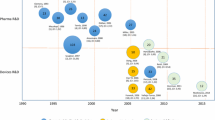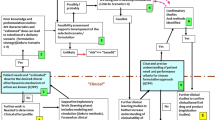Abstract
Pharmacoeconomics is vitally important to drug manufacturers in terms of communicating to external decision-makers (payers, prescribers, patients) the value of their products, achieving regulatory and reimbursement approval and contributing to commercial success. Since development of new drugs is long, costly and risky, and decisions must be made how to allocate considerable research and development (R&D) resources, pharmacoeconomics also has an essential role informing internal decision-making (within a company) during drug development.
The use of pharmacoeconomics in early development phases is likely to enhance the efficiency of R&D resource use and also provide a solid foundation for communicating product value to external decision-makers further downstream, increasing the likelihood of regulatory (reimbursement) approval and commercial success. This paper puts the case for use of pharmacoeconomic analyses earlier in the development process and outlines five techniques (clinical trial simulation [CTS], option pricing [OP], investment appraisal [IA], threshold analysis [TA] and value of information [VOI] analysis) that can provide useful input into the design of clinical development programmes, portfolio management and optimal pricing strategy.
CTS can estimate efficacy and tolerability profiles before clinical data are available. OP can show the value of different clinical programme designs, sequencing of studies and stop decisions. IA can compare expected net present value (NPV) of different product profiles or study designs. TA can be used to understand development drug profile requirements given partial data. VOI can assist risk management by quantifying uncertainty and assessing the economic viability of gathering further information on the development drug.
No amount of pharmacoeconomic data can make a bad drug good; what it can do is enhance the drug developers understanding of the characteristics of that drug. Decision-making, in light of this information, is likely to be better than that without it, whether it leads to faster termination of uneconomic projects or the allocation of more appropriate resources to attractive projects.
Similar content being viewed by others
References
Noyce R. Ch. 11. Project strategy. In: Matheson D, Matheson J, editors. The smart organisation: creating value through strategic R&D. Boston (MA): Harvard Business School Press, 1998: 221
Grabowski H. The effect of pharmacoeconomics on company research and development decisions. Pharmacoeconomics 1997; 11 (5): 389–97
Clemens K, Garrison LP, Jones A, et al. Strategic use of pharmacoeconomic research in early drug development and global pricing. Pharmacoeconomics 1993; 4 (5): 315–22
Datamonitor. Optimizing pharmacoeconomic return on investment. Benefits throughout the product life cycle. Datamonitor (report ref: DMHC1478) 2000
DiMasi JA, Caglarcan E, Wood-Armany M. Emerging role of pharmacoeconomics in the research and development decision-making process. Pharmacoeconomics 2001; 19 (7): 753–66
DiMasi JA, Hansen RW, Grabowski HG. The price of innovation: new estimates of drug development costs. J Health Econ 2003 Mar; 22 (2): 151–85
DiMasi JA. The value of improving the productivity of the drug development process: faster times and better decisions. Pharmacoeconomics 2002; 20 Suppl. 3: 1–10
Grabowski H, Vernon J, DiMasi J. Returns on research and development for 1990s new drug introductions. Pharmacoeconomics 2002; 20 Suppl. 3: 11–29
Annemans L, Geneste B, Jolain B. Early modelling for assessing health and economic outcomes of drug therapy. Value Health 2000; 3 (6: 427–34
O’Hagan A, Luce B. A primer on Bayesian statistics in health economics and outcomes research. Bethesda (MD): Medtap International, 2003
Briggs A. Statistical methods for cost-effectiveness research: a guide to current issues and future developments. London: OHE, 2003
Shih Y-CT. Bayesian approach in pharmacoeconomics: relevance to decision-makers. Expert Rev Pharmacoeconomics Outcomes Res 2003; 3 (3): 237–50
O’Hagan A, Stevens JW. Bayesian methods for design and analysis of cost-effectiveness trials in the evaluation of health care technologies. Stat Methods Med Res 2002; 11: 469–90
O’Hagan A, Stevens JW. Bayesian assessment of sample size for clinical trials of cost effectiveness. Med Decis Making 2001; 21: 219–30
Bonate PL. Clinical trial simulation in drug development. Pharm Res 2000; 17: 252–6
Hale M, Gillespie WR, Gupta S, et al. Clinical trial simulation as a tool for increased drug development efficiency [online]. Available from URL: http://www.actmagazine.com/applied clinical trials. [Accessed 2004 May 31]
Krall RL, Engleman KH, Ko HC, et al. Clinical trial modelling and simulation: work in progress. Drug Inf J 1998; 32: 971–6
Holford NH, Kimko HC, Monteleone JP, et al. Simulation of clinical trials. Annu Rev Pharmacol Toxicol 2000; 40: 209–34
Hughes DA, Walley T. Economic evaluations during early (phase II) drug development: a role for clinical trial simulations? Pharmacoeconomics 2001; 19 (11): 1069–77
Burman CF, Senn S. Examples of option values in drug development. Pharmaceut Statist 2003; 2: 113–25
Pearson A. The use of ranking formulae in R&D projects. R&D Management 1972; 2: 69–73
Senn S. Some statistical issues in project prioritization in the pharmaceutical industry. Stat Med 1996; 15: 2689–702
Senn S. Further statistical issues in project prioritization in the pharmaceutical industry. Drug Inf 1998; 32: 253–9
Palmer S, Smith P. Incorporating option values into the economic evaluation of health care technologies. J Health Econ 2000; 19: 755–66
Backhouse ME. An investment appraisal approach to clinical trial design. Health Econ 1998; 7: 605–19
Chilcott J, Brennan A, Booth A, et al. The role of modelling in the planning and prioritisation of clinical trials. Health Technol Assess 2003; 7 (23): iii, 1–125
Backhouse ME. Use of randomised controlled trials for producing cost-effectiveness evidence: potential impact of design choices on sample size and study duration. Pharmacoeconomics 2002; 20 (15): 1061–77
Backhouse ME. The use of discrete choice analysis in the design of randomised controlled trials [poster]. ISPOR; 2002 Nov 35; Rotterdam
Poland B, Wada R. Combining drug-disease and economic modelling to inform drug development decisions. Drug Discov Today 2001; 6 (22): 1165–70
Thompson D, Bird A, Weinstein M. Decision analysis in the drug development process: use of pharmacoeconomics to inform “go/no-go” decision-making. ISPOR Seminar; 2002 May 20; Boston
Claxton K. Bayesian approaches to the value of information: implications for regulation of new pharmaceuticals. Health Econ 1999; 8: 269–74
Claxton K, Neumann PJ, Araki S, Weinstein MC. Bayesian value-of-information analysis: an application to a policy model of Alzheimer’s disease. Int J Technol Assess Health Care 2001 Winter; 17 (1): 38–55
Claxton K, Posnett J. An economic approach to clinical trial design and research priority setting. Health Econ 1996; 5: 51324
Claxton K, Thompson KM. A dynamic programming approach to the efficient design of clinical trials. J Health Econ 2001 Sep; 20 (5): 797–822
Hawkins N, Claxton K. Optimal drug development programmes and efficient licensing and reimbursement rules: the role of value of information analysis. Abstract presented at Society Medical Decision Making 2003
Taylor RS, Drummond MF, Salkeld G, Sullivan SD. Inclusion of cost effectiveness in licensing requirements of new drugs: the fourth hurdle. BMJ 2004; 329: 972–5
Acknowledgements
Paul Miller is employed by AstraZeneca. The ideas expressed in this paper are entirely those of the author and do not necessarily represent the views or practices of AstraZeneca. AstraZeneca does not endorse the ideas expressed in this paper. I am grateful to my wise colleagues Dave Whynes and Fredrik Andersson for comments on earlier drafts.
Author information
Authors and Affiliations
Corresponding author
Rights and permissions
About this article
Cite this article
Miller, P. Role of pharmacoeconomic analysis in R&D decision making. Pharmacoeconomics 23, 1–12 (2005). https://doi.org/10.2165/00019053-200523010-00001
Published:
Issue Date:
DOI: https://doi.org/10.2165/00019053-200523010-00001




